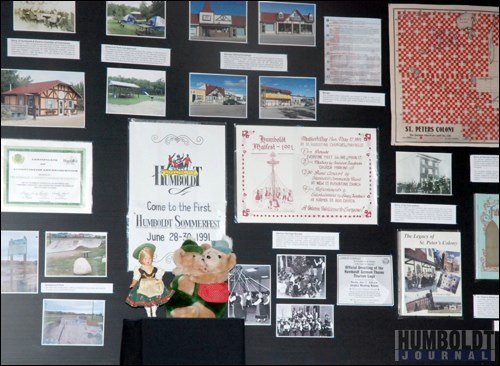A unique look at heritage is the theme of the latest exhibit at the Humboldt and District Museum and Gallery, entitled Humboldt's Heritage Resources.
The city has such a diverse array of heritage resources - from artwork to historic buildings to archival documents to natural green spaces.
Museum curator Jennifer Hoesgen and supervisor Brenda Duerr, wanted to find which places and historical events Humboldt's citizens felt were most important to the heritage of the city, so they conducted a survey in the community.
"Old is not necessarily criteria for value," Hoesgen said about the results people came up with during their study. "There were people that identified green spaces as something more important than, say, a building, for example."
Once the survey was completed and the data compiled, the two women identified 12 themes that represent what the community considered to be important in the heritage of Humboldt. They took this information, and with their team of summer co-workers, put together the exhibit.
The museum also won an award, The Saskatchewan Municipalities Award for Heritage Conservation Leadership for 2011, for the research and approach it used to conduct the analysis.
Things like faith, early settlers' origins, memorable moments in the arts, and excellence in sports are some of the themes that form the content of the exhibit, on display until September 29.
The design is simple, consisting of documents, maps or pictures pertaining to the themes, which have been grouped into sections and mounted onto black matt board.
Each section comprises images of these resources - people, places, events or buildings - that the community identified through the survey.
"There are also complementary artifacts to each theme," said Duerr. "Things we are preserving such as samples from the Original Humboldt Site (OHS) archaeological dig, or the conductor's hat and baton from the Lions Junior Marching Band."
Carefully enclosed in a plastic covering, two artifacts from the OHS dig sit next to two sepia-toned portraits of George and Catherine Weldon, who operated the original Humboldt telegraph station.
In another section, pictures and posters recall the arrival of German settlers in Humboldt, while a copy of a land map shows the area formerly known as St. Peter's Colony. On a little shelf beneath a German "Sommerfest" poster sit two teddy bears and a little doll dressed in traditional German costume.
A large section of the exhibit is devoted to illustrating the important role faith has played in Humboldt's history. Images of the early arrival of the Elizabethan Sisters in the area and of the Ursuline Sisters in Bruno document their life and work. Beside these, photographs of all the churches in Humboldt today are witness to the role religion continues to play.
Underneath this part of the exhibit, a section of the altar rail from the chapel of the first hospital in Humboldt adds a tactile element to the theme.
Sports has always been important for children and adults in Humboldt0, and the section of the exhibit devoted to sport tries to honour some of the most noteworthy figureheads and moments of the city's past.
An interesting addition to the section on sports is the touch screen computer that lets the visitor discover all of Saskatchewan's Hall of Fame Inductees.
It is an exhibit that illustrates the highlights of over a century of history in the Humboldt area. Many details are there to be discovered by the discerning visitor's eye.


.png;w=120;h=80;mode=crop)

